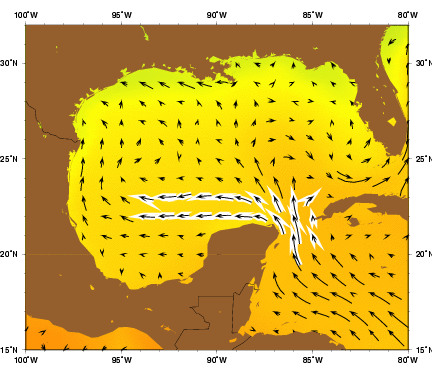
| ||
| The Yucatan current as represented by the Mariano Global Surface Velocity Analysis (MGSVA). Click here for example plots of seasonal averages. | ||
Pillsbury (1890) was among the first to take direct current measurements in the Yucatan Current region. He reported strong currents (170 cm s-1 at 6.3 m depth) flowing on the western side of the channel and southerly flows on the eastern side of the channel (Ochoa et al. 2001). The northward flow on the western side is now known as the Yucatan Current, and the southward flow on the eastern side was named the Cuban Countercurrent (Emilsson 1971; Ochoa et al. 2001). Underneath the Yucatan Current there is a southward Yucatan Undercurrent that is an important part of the upwelling mechanism at the Campeche Bank (Merino 1997; Ochoa et al. 2001).
US scientists (Cochrane 1966, 1968, 1969; Ruiz 1979) and Soviet-Cuban expeditions (Belousov et al. 1966; Bogodanov et al. 1968; Bessonov et al. 1971; Bulanienkov and Garcia 1973) reported upwelling along the eastern edge of the Yucatan Shelf years ago (Merino 1997). However, most of their data were published in reports that are not readily accessible in the scientific literature. International efforts to study the Yucatan Shelf were scarce after 1973 because Mexico claimed this area during the International Conference on the Law of the Sea as part of the Mexican Exclusive Economic zone (Merino 1997).
Because the current is on a western boundary and for other reasons, scientists thought that wind-driven divergence might not be an important mechanism for upwelling in the Yucatan region (Merino 1997). Cochrane (1968, 1969) suggested that bottom friction of the strong Yucatan Current against the slope on the eastern edge of the Yucatan Shelf caused the upwelling instead. Another possible mechanism was proposed by Garcia (1990), who speculated that the upwelling is a result of interactions between the Yucatan Current and the countercurrent that Bulaniekov and Garcia (1973) found (Merino 1997).
Merino (1997) used hydrographic data from four cruises to study upwelling on the Yucatan Shelf and to describe its structure. Subsurface Caribbean water from depths of 220-250 m upwelled at about 10-2 cm s-1 along the eastern slope of the Yucatan Shelf into the euphotic zone, but it rarely broke the sea surface. It was characterized by temperatures of 16 to 20°C and salinity of 36.1 to 36.5. The upwelling appeared to have a seasonal cycle. During spring and summer, the upwelled water created a two-layered column over the Yucatan Shelf. Because there was strong stratification between the Caribbean Surface Water and the upwelled water, the two layers did not mix easily until the winter months, when there were periods of northern winds.
Molinari and Cochrane (1972) used surface current vector fields to show that the Yucatan Current initially follows the bathymetry from 21°N to 24.5°N. Then, it changes direction from northerly to northwesterly at 23.5°N, 87°W in May. At 24.5°N, 87.5°W, the topographic gradients become steep and run in a westward direction, and the current actually flows perpendicular to the topography (Molinari 1988). Cochrane (1966) suggested that the current cannot follow sharp turns such as this, so it moves into deeper water where it is not directly in contact with the bottom (Molinari 1988).
Early transport estimates by Schlitz (1973) for the Yucatan Current ranged from 23 Sv to 33 Sv (Ochoa et al. 2001). However, Ochoa et al. (2001) showed that since there is no definite level of no motion in the Yucatan Channel, classical geostrophic calculations may not provide an accurate description of the transport. The latest data come from Sheinbaum et al. (2002), who found 23.8 ±1 Sv of mean transport in the Yucatan Channel during 10 months of measurements. This is less than the 28 Sv of transport normally attributed to the Yucatan and the 30 Sv accepted as the nominal transport of the Florida Current. Since the transport of the Florida Current has been shown to be very stable (Larsen 1992), Sheinbaum et al. do not suggest a reduction of 4.5 Sv in its mean transport during the period of their observations. Instead, they suggest that transport through the other channels in the Antilles may be more variable than previously thought. The Windward Passage especially requires further study (Roemmich 1981; Johns et al. 2002; Sheinbaum et al. 2002).
Ochoa et al. (2001) were the first to report a mean southerly flow on the eastern side of the Yucatan Channel between 500 and 1500 m depth. They speculated that the 2 Sv of water it transports are the recirculation of waters of the same depth that enter the Gulf of Mexico as the Loop Current. The water that cannot flow out of the gulf through the Florida Straits apparently returns to the Caribbean Sea in this fashion.
The penetration of the Loop Current into the Gulf of Mexico has been linked to different characteristics of the Yucatan Current (Molinari 1988). Reid (1972), in an empirical model, found that the speed and angle of the Yucatan Current as it separates from the Campeche Bank affects the northward penetration of the Loop. When the Yucatan Current separates from the eastern Campeche Bank, the Loop intrusion is shallow. On the other hand, when the separation occurs farther west, the Loop Current penetrates deeper into the gulf (Molinari 1988).